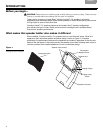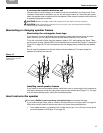
6
P
REPARATION
EnglishFrançaisNederlands DeutschItaliano
Deciding on speaker placement
The design of your new Virtually Invisible
®
191 speakers makes them well-suited to either wall
or ceiling installation. The location you choose will affect the procedure for installing them.
Consider the options below, then follow the instructions that apply to your choices:
• How you will use the speakers?
• for stereo sound at the front of a room or seating arrangement, or
• as home theater front speakers or surround sound rear speakers
• What surface will you install them in?
• an interior wall (abutting another room), or exterior wall (abutting outside), or ceiling
• in finished (plaster and lath or wallboard), or new construction
Three tips for determining speaker placement
1. The template can be placed against a wall or ceiling to help determine the amount of
space the speaker will need. Each speaker enclosure extends into the wall or ceiling, as
shown in the gray DO NOT CUT area on the template (Figure 4). In a wall, the speaker
may be inserted either up or down and will extend either above or below the grille.
2. Use of a stud finder can help ensure that the speaker hole is at least 4
3
/
4
in. (12 cm) from
a stud or joist.
3. All electrical wiring, vents and plumbing pipes located inside the walls must be avoided
(Figure 5 on page 7). Check with a trained professional to learn how to locate and avoid
them.
Note:
To prevent problems with condensation in cold climates where a humidifier is used, avoid
inserting the speaker upside-down in an exterior wall.
Figure 4
Template
5
1
/
2
" (14 cm)
DO NOT
CUT AROUND
GRAY AREA
8
1
/
16
" (20.5 cm)
14
1
/
2
" (36.9 cm)
TAPE
HERE
TAPE
HERE
TAPE
HERE
WHITE CUT OUT AREA
WHITE CUT OUT AREA
Pilot Hole
WARNING: Make sure the spot chosen is safe for cutting. Do not cut through
surfaces that have hazards, such as electrical wiring, conduits or plumbing,
concealed behind them. If you are not sure, consult a professional installer
before you proceed.
DO NOT
CUT AROUND
GRAY AREA
DO NOT
CUT AROUND
GRAY AREA
DO NOT
CUT AROUND
GRAY AREA
DO NOT
CUT AROUND
GRAY AREA
DO NOT
CUT AROUND
GRAY AREA
DO NOT
CUT AROUND
GRAY AREA
DO NOT
CUT AROUND
GRAY AREA
English &
English &
Translations
ranslations
WARNING: Make sure the spot chosen is safe for cutting. Do not cut through surfaces that have hazards, such as electrical
wiring, conduits or plumbing, concealed behind them. If you are not sure, consult a professional installer before you proceed.
WARNING: Make sure the spot chosen is safe for
drilling. Do not cut through surfaces that have hazards
concealed behind them, such as electrical wiring,
conduits or plumbing. If you are not sure, consult a
professional installer before you proceed.
WARNING: Make sure the spot chosen is safe for
drilling. Do not cut through surfaces that have hazards
concealed behind them, such as electrical wiring,
conduits or plumbing. If you are not sure, consult a
professional installer before you proceed.
WARNING: Make sure the
spot chosen is safe for
drilling. Do not cut through
surfaces that have hazards
concealed behind them,
such as electrical wiring,
conduits or plumbing. If you
are not sure, consult a
professional installer before
you proceed.
WARNING: Make
sure the spot chosen
is safe for drilling. Do
not cut through
surfaces that have
hazards concealed
behind them, such
as electrical wiring,
conduits or
plumbing. If you are
not sure, consult a
professional installer
before you proceed.
WARNING: Make sure the spot chosen is safe
for drilling. Do not cut through surfaces that have
hazards concealed behind them, such as
electrical wiring, conduits or plumbing. If you
are not sure, consult a professional installer
before you proceed.
WARNING: Make sure the spot
chosen is safe for drilling. Do not cut
through surfaces that have hazards
concealed behind them, such as
electrical wiring, conduits or plumbing.
If you are not sure, consult a
professional installer before you
proceed.
9" (22.9 cm)
TAPE
HERE
Translations below
TAPE
HERE
TAPE
HERE
FOR CUTTING
Large white area
represents what to cut
out for the speaker face.
NOT FOR CUTTING
Large gray area
represents space to
reserve behind the wall
for the speaker
enclosure.


















